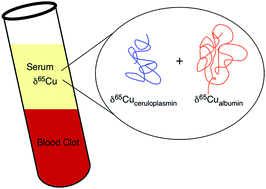Computational modelling of the redistribution of copper isotopes by proteins in the liver†
Abstract
Changes in the stable isotope composition of copper in blood serum as a result of biological processes in the liver were quantified as coupled equilibrium fractionation processes. The model used calculated reduced partition function ratios corresponding to interactions involving individual proteins using Density Functional Theory. This quantified the effect that each process had on the redistribution of copper isotopes in the liver. It was not possible to calculate the reduced partition function of CTR1 as a high resolution crystal structure of its copper binding domains are unavailable at the time of writing, and an optimization process was used to estimate the reduced partition function of CTR1 and constrain the possible isotopic fractionation associated with interactions involving CTR1 independent of direct DFT calculations and assumptions of its structure. The exchange of copper between ceruloplasmin and ATP7B has the most significant impact on the copper isotopic composition of blood serum. The model calculation for the isotopic composition of ceruloplasmin and albumin are δ65Cu = (−0.54 ± 0.10)‰ and δ65Cu = (0.08 ± 0.25)‰ respectively, assuming that serum is 90% ceruloplasmin and 10% albumin using a measured δ65Cu of serum of (0.52 ± 0.08)‰. The model also predicts that the isotopic composition of the tri-nuclear binding motif of ceruloplasmin may be relatively depleted in the lighter isotope of Cu compared to the other copper binding sites by as much as −1.08 ± 0.45‰.



 Please wait while we load your content...
Please wait while we load your content...